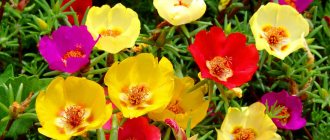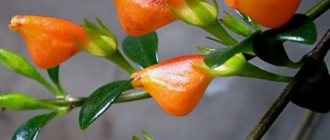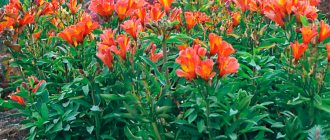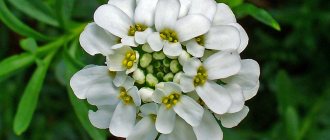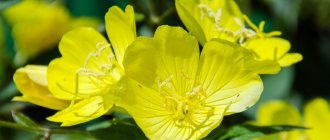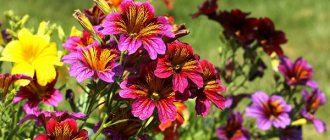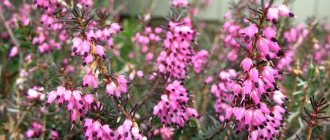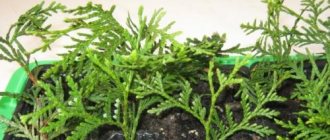The Alocasia plant is a large shrub up to 4 meters in height and 1.5 meters in width. The flower's homeland is the tropical forests of South Africa and areas of the Pacific District. This crop is distinguished by beautiful foliage and powerful thick shoots.
Alocasia leaves have a waxy surface that repels excess moisture. In addition, they secrete residual liquid that was not absorbed by the flower during feeding.
Varieties of Alocasia
Today, flower shops offer a large selection of species of this crop. They differ from each other in their size and leaf diameter. The most popular are:
Alocasia large-rooted
She is the largest among the representatives of this species. The height of the bush is up to 4 meters. It is very difficult to grow such a flower at home. Most often, it begins to mutate and stops growing at a height of 1.5 meters. The leaves of the flower reach gigantic sizes.
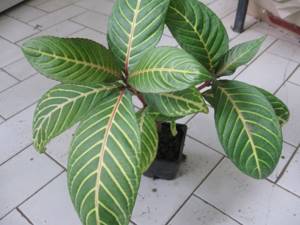
After the flowering period, numerous fruits are formed in place of the flower stalks, which are not suitable for human nutrition.
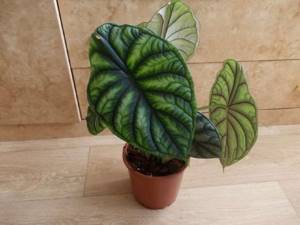
In Malaysia, they are eaten after several heat treatments. This will remove all toxic substances from the fruit.

Alocasia amazonica
The height of an adult flower is 20-35 cm. The leaf blades have an unusual cellular structure. Along the entire perimeter of the leaf plates there are thick veins of a light green hue.
This type of Alocasia flower blooms profusely and very often. The peduncle is a long branch, at the end of which there are small flowers. They start out as calla lilies in appearance.
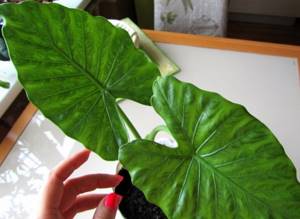
Alocasia copper-red
The leaf blades are heart-shaped. The lower part of the leaves has a purple tint, and the outer part is copper-red. It grows very slowly. The height of an adult plant reaches up to 35 cm in height.
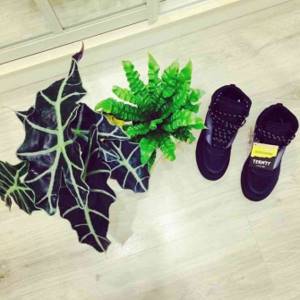
Alocasia dragon
It received this name due to its leaves. They resemble the wings of a mythical monster. Along the entire perimeter there are thick veins of a light shade. The photo of alocasia shows the best varieties of shrubs.
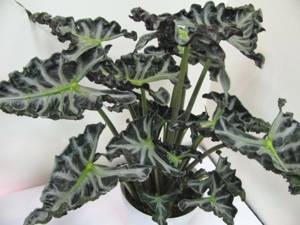
Description
Alocasia polli is one of the hybrids of the Alocasia sandera flower. This is a fairly tall evergreen shrub flower. In the natural environment it can reach up to 2 meters. The length of the indoor plant is from 20 to 50 cm, under favorable conditions - 70 cm. The main advantage of the flower is its fairly large leaves. There can be about 30 of them on each bush. When new leaves appear, the old ones die off.
Distinctive features of the flower:
| Plant parts | Description |
| Leaves | Heart-shaped with tooth-shaped edges. Green in color with light veins, they have a metallic sheen in the sun. Up to 0.5 m long, up to 20 cm wide, on thick and short petioles. |
| Stem | Powerful, grows vertically. |
| Flowers | In rare cases, inflorescences-cobs with white or pink flowers exuding a rich aroma may appear on an adult bush. After pollination, berries with seeds appear. |
| Root system | Relatively compact. |
| Hydration packs | Serve to remove excess moisture. Feature of this variety. |
How to care?
Before purchasing this type of shrub, it is recommended that you familiarize yourself with the rules of care at home. It includes the following items:
- lighting;
- watering;
- feeding;
- temperature regime;
- reproduction.
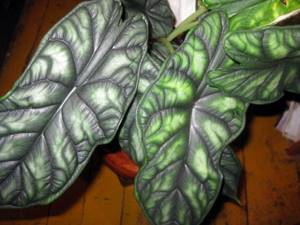
This culture prefers plenty of light. Do not place the flower in direct sunlight. They negatively affect the well-being of the ornamental plant. As a result, it may change color or dry out.
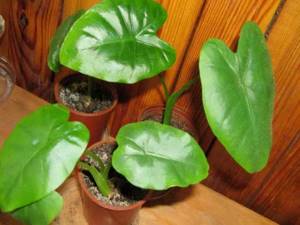
Diseases and pests
What does the plant suffer from? Trefoil is loved by spider mites, spider mites and thrips. To destroy them, the leaves and stems are sprayed with insecticides. To prevent the proliferation of pests, add a soap solution (household soap) or tobacco to the spraying water.
The plant can die without being attacked by pests if the leaves do not have enough light. In this case, they turn yellow, wither and dry out. Sometimes the color becomes faded. If you add an additional light source or move the flowerpot to the south or southwest side, the color intensity is restored.
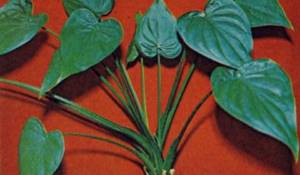
Also, alocasia can get sick and lose its decorative properties if there is an excess/lack of mineral nutrition. Therefore, it is necessary to carefully observe the regime and dosage of minerals and ensure appropriate watering. If you don't water it enough, the trefoil will dry out, and if you water it too much, it will rot.
Watering a flower
For active growth of the shrub, it is necessary to provide high humidity. Frequent watering should be carried out in the summer. In winter, it is reduced to 1 time every 2 weeks.
To do this, use soft and purified water. It is pre-cleaned using a filter. Hard tap water can cause slow growth and frequent diseases of the root system.
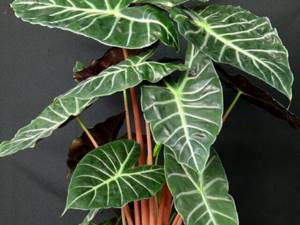
Caring for Alocasia Sandera
Alocasia Sandera is a tropical flower and grows well in a warm, humid environment. The temperature should be +20-26 degrees Celsius, in winter not lower than +18 degrees Celsius. Watering is moderate, preventing the soil from drying out. Loves frequent spraying. The plant is light-loving and requires free space around to grow; it will simply wither in the corner of the room.
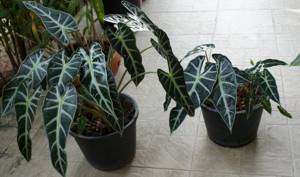
The plant is replanted as it grows, but at least once every two years, at the end of winter. The soil should be loose, free-flowing with the addition of peat, leaf humus and sand; it is better to purchase it in specialized stores. For stability, since the plant is massive, choose a pot with thick walls, and be sure to lay drainage at the bottom, which you can also buy ready-made in the store. The plant propagates by cuttings and seeds.
During flowering, more abundant watering and fertilizing are required. Potassium-based fertilizers should be applied at least once a month. Some gardeners advise plucking off the inflorescence to avoid the withering of the leaves, which contain all the beauty. In winter, the plant is dormant and does not require such careful care.
Top dressing
Proper feeding activates rapid growth and beautiful flowering for a long time. For alocasia, mineral complex compositions based on potassium-phosphorus mixtures are used.
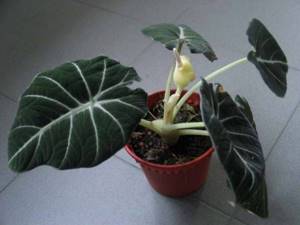
It is necessary to feed the flower in early spring or late autumn before hibernation. Fertilizers are diluted in a proportion of 10 g per 1 liter of warm water. The liquid is thoroughly mixed and watered or sprayed.
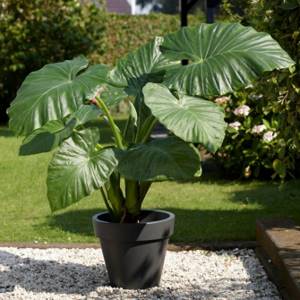
Alocasia treatment recipes
Vodka tincture
The crushed, mashed lower leaves are poured with vodka. You will need equal amounts of leaves and vodka. The composition is left in a place closed to light for 21 days. The finished product is filtered. The main area of application of alocasia tincture is compresses and lotions for diseases of the skin and joints. It is effective in the treatment of thrombophlebitis and helps against hemorrhoids. They begin to take the alocasia tincture very carefully on the first day of taking one drop with water, the second two, and so on for a month, increasing it drop by drop every day. Then the quantity is reduced.
» » » » Benefits and harms of the aucuba flower “ “ “ “
Tincture with honey for the stomach
0.5 l vodka, 2 tbsp. pulp of leaves, a glass of natural honey. Combine the listed ingredients, shake until the honey is completely dissolved, and leave for ten days in a cold, dark place. Treatment with alocasia tincture lasts two weeks. Take 1 tbsp. 20 minutes before meals.
You may also be interested in: Calendula flowers
Ointment for joints
The leaves, ground to a homogeneous paste, are combined with fat. The base can be animal fat, petroleum jelly or lanolin. Treatment with alocasia ointment is used for joint and rheumatic pain, for healing ulcers, and wounds that do not heal for a long time.
» » » » Benefits and harms of diatum « « « «
Oil composition
For 100 ml of vegetable oil you will need one crushed leaf. The composition is placed for 14 days in a dark glass container, then filtered. An infusion of oil is effective for joint pain. Treatment with alocasia is carried out daily for ten days, then take a break for 7 days and continue until positive results.
Baths
This procedure is useful for all joint diseases. To prepare, the leaves of the plant are crushed and poured with a liter of boiling water for an hour. Take baths for no more than twenty minutes daily.
Reproduction of alocasia
How can you propagate alocasia at home? There are four ways to propagate flower crops:
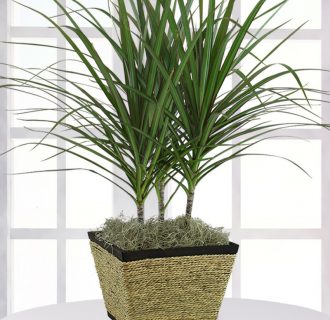
Dracaena: rules of care at home. Planting, growing and tips for choosing a location (155 photos)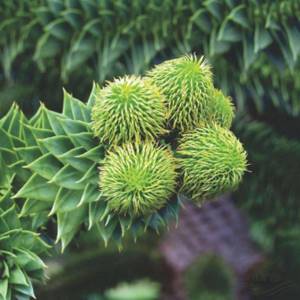
Araucaria - caring for indoor and garden flowers with your own hands. Growing and propagating decorative flowers (135 photos and videos)
- Bamboo curtains - material features and combination options
- seeds;
- dividing the bush;
- tubers;
- cuttings.
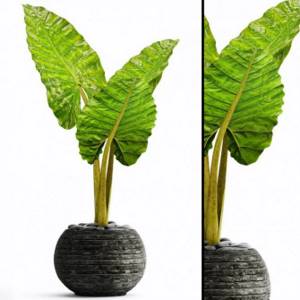
You can get seeds by pollinating two varieties of flowers. After this, small fruits appear. They contain small seeds. They are dried for a week in the fresh air.
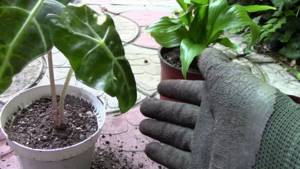
Next, they are planted in loose soil. It is recommended to carry out this event in early spring.
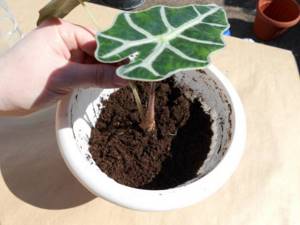
Cuttings are carried out by cutting the shoot at an angle of 45 degrees. The sharp part is placed in the root and planted in soft soil. Next, greenhouse conditions are created for 3 months. In the 4th month, small tubers begin to form.

